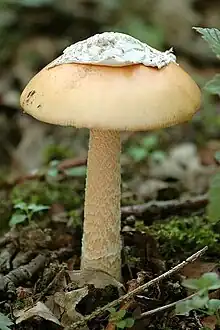| Amanita polypyramis | |
|---|---|
_Sacc_978394.jpg.webp) | |
| Scientific classification | |
| Domain: | Eukaryota |
| Kingdom: | Fungi |
| Division: | Basidiomycota |
| Class: | Agaricomycetes |
| Order: | Agaricales |
| Family: | Amanitaceae |
| Genus: | Amanita |
| Species: | A. polypyramis |
| Binomial name | |
| Amanita polypyramis (Berk. & M.A. Curtis) Sacc. 1887 | |
| Amanita polypyramis | |
|---|---|
| Gills on hymenium | |
| Cap is convex or flat | |
| Hymenium is free | |
| Stipe has a ring and volva | |
| Spore print is white | |
| Ecology is mycorrhizal | |
| Edibility is unknown | |
Amanita polypyramis is a species of Amanita found in Eastern United States. Though listed in some sources as ranging from New Jersey, to Costa Rica in Central America, the species has been found as far north as New England, concentrated largely in Cape Cod.[1][2]
It is a large, bone white mushroom with a chlorine like odor. Its species name, polypyramis, refers to the pyramid-like warts on the surface of the pileus.[3]
References
- ↑ "Amanita polypyramis - Taxonomy and Morphology of Amanita and Limacella". Amanitaceae.org. Retrieved 2022-12-10.
- ↑ "Amanita polypyramis Observations". inaturalist.org. Retrieved 2023-11-12.
- ↑ "Mycology is Better Than Yours: The Kingdom Fungi" (PDF). Texas Master Naturalist Program. Retrieved 2023-11-12.
External links
 Media related to Amanita polypyramis at Wikimedia Commons
Media related to Amanita polypyramis at Wikimedia Commons Data related to Amanita polypyramis at Wikispecies
Data related to Amanita polypyramis at Wikispecies
This article is issued from Wikipedia. The text is licensed under Creative Commons - Attribution - Sharealike. Additional terms may apply for the media files.
